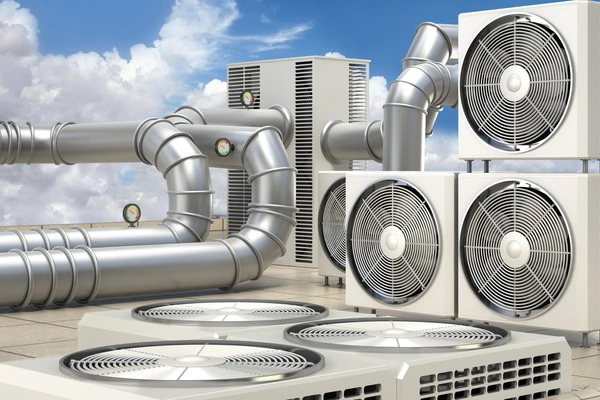Explore how BIM technology is revolutionizing HVAC systems, thereby making your indoor environment not just comfortable but also efficient. In this blog, we will delve into how HVAC systems impact buildings. Additionally, we will discuss BIM’s crucial role in HVAC design, emphasizing occupant comfort and sustainability. Ultimately, let’s explore HVAC science and BIM benefits for creating better buildings that are comfy, healthy, and eco-friendly.
To know more about HVAC System:-https://pinnacleiit.com/blogs/bim/what-is-hvac-design-means-full-form-details-explanation/
Understanding HVAC Systems: The Backbone of Indoor Comfort:-
HVAC systems are integral to maintaining thermal comfort, indoor air quality (IAQ), and humidity control within buildings. These systems regulate temperature, humidity levels, and airflow to create optimal conditions for occupants, enhancing productivity, health, and overall well-being. Buildings go green with advanced HVAC tech to save energy and maintain reliability while minimizing environmental impact.
The Role of BIM in Transforming HVAC Systems:-
BIM revolutionizes the design and management of HVAC systems by employing digital tools for simulation, coordination, and lifecycle management. Consequently, it enhances efficiency significantly.BIM brings together engineers, architects, and contractors to collaborate as a team, thereby creating efficient HVAC designs in a virtual space. Consequently, this helps improve system performance, save energy, and reduce operating expenses. By integrating BIM with HVAC workflows, stakeholders can visualize, analyze, and refine designs to meet functional requirements while adhering to sustainability goals and regulatory requirements.
BIM’s Approach: Excellence in Education and Technological Integration:-
Central to our curriculum in environmental engineering and building design at BIM is HVAC innovation. Specifically, we emphasize a comprehensive approach that combines theoretical knowledge with hands-on experience using BIM tools. By engaging in practical projects, research initiatives, and industry partnerships, BIM effectively prepares future professionals to harness technological innovations. Additionally, they are empowered to lead transformative change in HVAC engineering, guiding the industry towards sustainable and energy-efficient solutions.
The Journey of HVAC Innovation: Advances and Applications:-
Advancements in HVAC technology, therefore, encompass a wide range of innovations. These innovations serve to enhance system efficiency, reliability, and sustainability. Here are key areas where BIM plays a pivotal role in advancing HVAC systems:
1. Energy-Efficient HVAC Design:-
Integrated Design: Collaborating across disciplines to integrate passive design strategies, such as building orientation, shading, and natural ventilation, into HVAC systems using BIM’s modeling and simulation capabilities.
Energy Modeling: By leveraging BIM technology to simulate HVAC system performance, engineers can thoroughly analyze energy consumption. Consequently, they can optimize equipment selection, layout, and controls, leading to maximum efficiency and operational savings.
2. Advanced Controls and Automation:-
Building Automation Systems (BAS): By integrating BAS with BIM, we can monitor and control HVAC equipment. Consequently, we optimize energy use in real-time. Additionally, we adjust settings based on occupancy patterns, weather conditions, and indoor environmental quality metrics..
Predictive Maintenance: By implementing IoT sensors and data analytics, we can not only predict equipment failures but also schedule proactive maintenance. Consequently, this helps optimize system performance and longevity.
3. Sustainable Refrigerants and Heat Recovery:-
Low-GWP Refrigerants: By transitioning to environmentally friendly refrigerants with lower Global Warming Potential (GWP), we can reduce greenhouse gas emissions and, consequently, comply with regulatory standards. Furthermore, this shift supports global efforts to combat climate change.
Heat Recovery Systems: Designing and implementing heat recovery systems using BIM to capture waste heat from HVAC operations for space heating, water heating, or preheating ventilation air, improving overall energy efficiency.
HVAC Innovation: Impact on Comfort and Sustainability:-
Behind every HVAC innovation lies a profound human impact. By integrating BIM with HVAC engineering practices, BIM ensures:
Occupant Comfort: Creating indoor environments that optimize thermal comfort, air quality, and acoustic performance, enhancing productivity, health, and well-being.
Energy Savings: Lowering energy consumption and operational costs for building owners and tenants through efficient HVAC design and management strategies.
Environmental Stewardship: Reducing carbon footprint and promoting sustainable building practices by minimizing energy use and greenhouse gas emissions associated with HVAC operations.
Innovating for a Sustainable Future: Collaboration and Adaptation:-
As buildings strive to meet increasingly stringent energy efficiency and sustainability goals, BIM facilitates collaboration and adaptation within HVAC engineering:
Lifecycle Management: Using BIM’s capabilities for ongoing monitoring, maintenance, and optimization of HVAC systems to ensure long-term performance and reliability.
Interdisciplinary Collaboration: Collaborating with architects, engineers, contractors, and facility managers to integrate HVAC solutions that meet functional requirements, enhance occupant comfort, and achieve sustainability objectives.
Your Role in HVAC Innovation: Empowering Change:-
Studying HVAC innovation through BIM at BIM is more than acquiring technical skills; it’s embracing a commitment to sustainability, innovation, and enhancing quality of life. Whether you aspire to design energy-efficient systems, optimize building performance, or advocate for sustainable practices, your journey begins here.
Conclusion: Shaping a Sustainable Built Environment Together:-
In conclusion, HVAC innovation through BIM exemplifies the convergence of technology, expertise, and human-centered design. By humanizing the science and understanding its profound impact on buildings and communities, we empower ourselves to create environments that are efficient, comfortable, and sustainable.
Join us at BIM in embracing the challenge and privilege of advancing HVAC innovation. Together, let’s innovate, collaborate, and build a future where buildings not only meet functional needs but also contribute positively to our planet’s health and resilience, ensuring a sustainable legacy for future generations.
Read more on:-
For more information about engineering, architecture, and the building & construction sector, go through the posts related to the same topic on the Pinnacle IIT Blogs page.
Find out more accurately what we are going to take off in the course of applying leading new technologies and urban design at Pinnacle IIT.
Subscribe to our YouTube channel and blog websites to obtain all the up-to-date information relating to construction matters.

